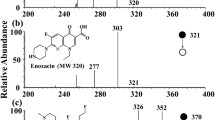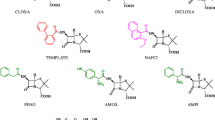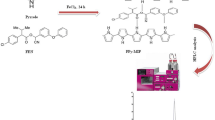Abstract
In this work, an analytical method for simultaneous analysis of several quinolones (cinoxacin, oxolinic acid, nalidixic acid, and flumequine) and fluoroquinolones (norfloxacin, enrofloxacin, enoxacin, ciprofloxacin, and danofloxacin) in baby-food samples is described for the first time. The method is based on isolation of these analytes by ultrasound-assisted extraction procedure followed by a solid-phase extraction sample clean-up step and final determination of the analytes by HPLC using UV detection. For the extraction step, 2 g baby food was mixed with methanol in a centrifuge tube and one single extraction cycle of 15 min at room temperature was carried out. After centrifugation, supernatant was collected and two different solid-phase extraction procedures were developed and evaluated for sample clean-up. The first was based on use of strong anion-exchange cartridges whereas the second was based on use of a ciprofloxacin-imprinted polymer. Both sample clean-up procedures had their own advantages and drawbacks, and the analytical performance and applicability of each procedure was established and properly discussed. The anion-exchange resin-based method enabled simultaneous determination of quinolones and fluoroquinolones, reaching limits of detection ranging from 0.03 to 0.11 μg g−1. In contrast, the use of a ciprofloxacin-imprinted polymer did provide selectivity towards fluoroquinolones, leading to chromatograms free from co-extractives reaching limits of detection one order of magnitude lower than those obtained by the first approach.





Similar content being viewed by others
References
Agarwal VK (1992) Drug residues of food products of animal origin. Plenum Press, New York
Aerts MML, Hogenboom AC, Brinkman UATh (1995) J Chromatogr B 667:1
Fidler DP (1999) Microbes Infect 1:29
Sáenz Y, Zarazaga M, Lantero M, Gastanares J, Baquero F, Torres C (2000) Antimicrob Agents Chemother 44:271
Petersen A, Andersen JS, Kaewmak T, Somsiri T, Dalsgaard A (2002) Appl Environ Microbiol 68:6036
Zaidi MB, Zamora E, Diaz P, Tollefson L, Fedorka-Cray PJ, Headrick ML (2003) Antimicrob Agents Chemother 47:1999
Agarwal VK (1992) J Chromatogr 624:411
Gendrel D, Chalumeau M, Moulin F, Raymond J (2003) Lancet Infect Dis 3:537
Kemp I, Gesbert M, Guitel M, Bennejean G (1992) Res Vet Sci 53:257
Mann DD, Frame GM (1992) Am J Vet Res 53:1022
Okerman L, Noppe H, Cornet V, de Zutter L (2007) Food Add Contam 24:252
EU Directive 1999/39/CE and subsequent amendments 1999/50/CE, 2003/13/CE and 2003/14/CE
Hernández-Artesos JA, Barbosa J, Compañó R, Prat MD (2002) J Chromatogr A 945:1
Samanidou VF, Nikolaidou KI, Papadoyannis LN (2007) J Sep Sci 30:2430
Christodoulou EA, Samanidou VF (2007) J Sep Sci 30:2421
Pikkemaat MG, Mulder PPJ, Elferink JWA, Cocq A, Nielen MWF, van Egmond HJ (2007) Food Addit Contam 24:8
Hossouan MK, Ballesteros O, Taoufiki J (2007) J Chromatogr B 852:625
Herranz S, Moreno-Bondi MC, Marazuela MD (2007) J Chromatogr A 1140:63
Juan-García A, Font G, Picó Y (2007) Electrophoresis 28:4180
Juan-García A, Font G, Picó Y (2006) Electrophoresis 27:2240
Clemente M, Hermo MP, Barron D, Barbosa J (2006) J Chromatogr A 1135:170
Bailac S, Barron D, Barbosa J (2006) Anal Chim Acta 580:163
Gentili A, Peret D, Marchese S, Sergi M, Olmi Ch, Curini R (2004) J Agric Food Chem 52:4614
Turiel E, Martín-Esteban A, Tadeo JL (2007) J Chromatogr A 1172:97
Turiel E, Bordin G, Rodríguez AR (2005) J Sep Sci 28:257
Acknowledgements
Authors wish to thank Spanish Ministry of Education and Science (AGL2005–00905) for financial support.
Author information
Authors and Affiliations
Corresponding author
Rights and permissions
About this article
Cite this article
Díaz-Alvarez, M., Turiel, E. & Martín-Esteban, A. Selective sample preparation for the analysis of (fluoro)quinolones in baby food: molecularly imprinted polymers versus anion-exchange resins. Anal Bioanal Chem 393, 899–905 (2009). https://doi.org/10.1007/s00216-008-2300-9
Received:
Revised:
Accepted:
Published:
Issue Date:
DOI: https://doi.org/10.1007/s00216-008-2300-9




